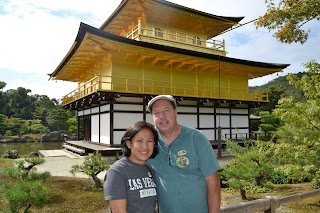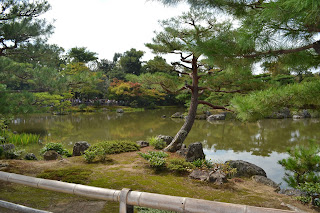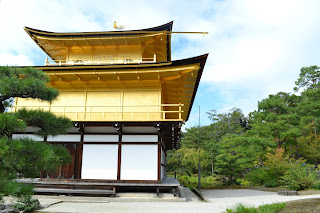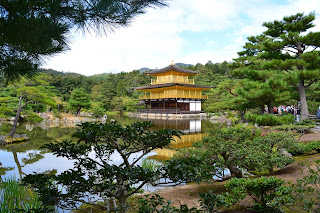October 9, 2014
Part Two of JTB Tour 1
I've only seen it in pictures before. But to finally see it in person? I'm speechless! The gold-leaf covered floors of Kinkaku-ji Temple make it a striking sight. Even the surrounding pond, with its still waters, boasts a reflection that is just as stunning.
 |
| Even with so many tourists, we were able to take our turn in getting a good photo. |
 |
| The Kinkaku-ji Temple (or Golden Pavilion) in all its splendor |
 |
| View of the reflective pond from the opposite side |
The second part of JTB USA's Kyoto morning tour brought us to this popular site. It's highly recommended for first-time visitors to Kyoto.
 |
| Seen at the First Gate: Tourists and students flocking to the world heritage site |
 |
| Five golden rules to follow at the entrance |
The original villa in this area was owned by a statesman named Saionji Kintsune. A shogun named Ashikaga Yoshimitzu bought it from him in 1937 and then built his own villa. After Yoshimitzu's death, and as a fulfillment of his will, the villa was converted into a Zen Buddhist temple.
 |
| The second and third floors are covered with gold foil on lacquer. At the top, is a golden phoenix. |
Each floor of this temple represents a different architectural style:
1st floor - built in the Shinden style used for palace buildings (11th century imperial aristocracy)
2nd floor - built in the Bukke style used in samurai homes (warrior aristocracy)
3rd floor - built in the style of Chinese Zen Hall
 |
| Each floor depicts a different architectural style |
The pavilion is not open to the public so we weren't able to go inside. I later learned that one might be able to spot the statues of the Shaka Buddha and Yoshimitzu on the first floor. I wish I had known this beforehand. Across the pond, the statues would have been viewable through the open windows of the first floor. I didn't see them but you can find photos here.
 |
| Statues inside the first floor can be viewed through its open windows |
The garden, with the pond and the Golden Pavilion, is definitely a place of Zen. It deserves the title "Special Place of Scenic Beauty." Our JTB tour guide gave us enough time to roam around and stroll through the gardens. There's so much to discover.
If you ever visit this beautiful place, make sure to look for the Ryumon Taki or Carp Rock. A waterfall cascades onto this rock that looks like a carp trying to swim upstream. The story is that the carp rock symbolizes strength, courage, and the will to persevere in times of adversity.
 |
| This is the Galaxy Spring or Ginga-sen. The shogun Yoshimitzu used water from this spring for his tea ceremony. |
 |
| The 600-year old bonsai tree in the shape of a boat. |
 |
| This shrine houses the stone statue of Fudo-do, known for miraculous powers. |
From some of the photos above, you couldn't tell that there were so many tourists. It was challenging to get photos without unwanted people in the shot. Thankfully, the tourists were gracious enough to allow each one to take his turn in getting a good photo. But don't let that discourage you. Visiting this historic site is worth every minute.
Continued from Nightingale Floors.




No comments:
Post a Comment